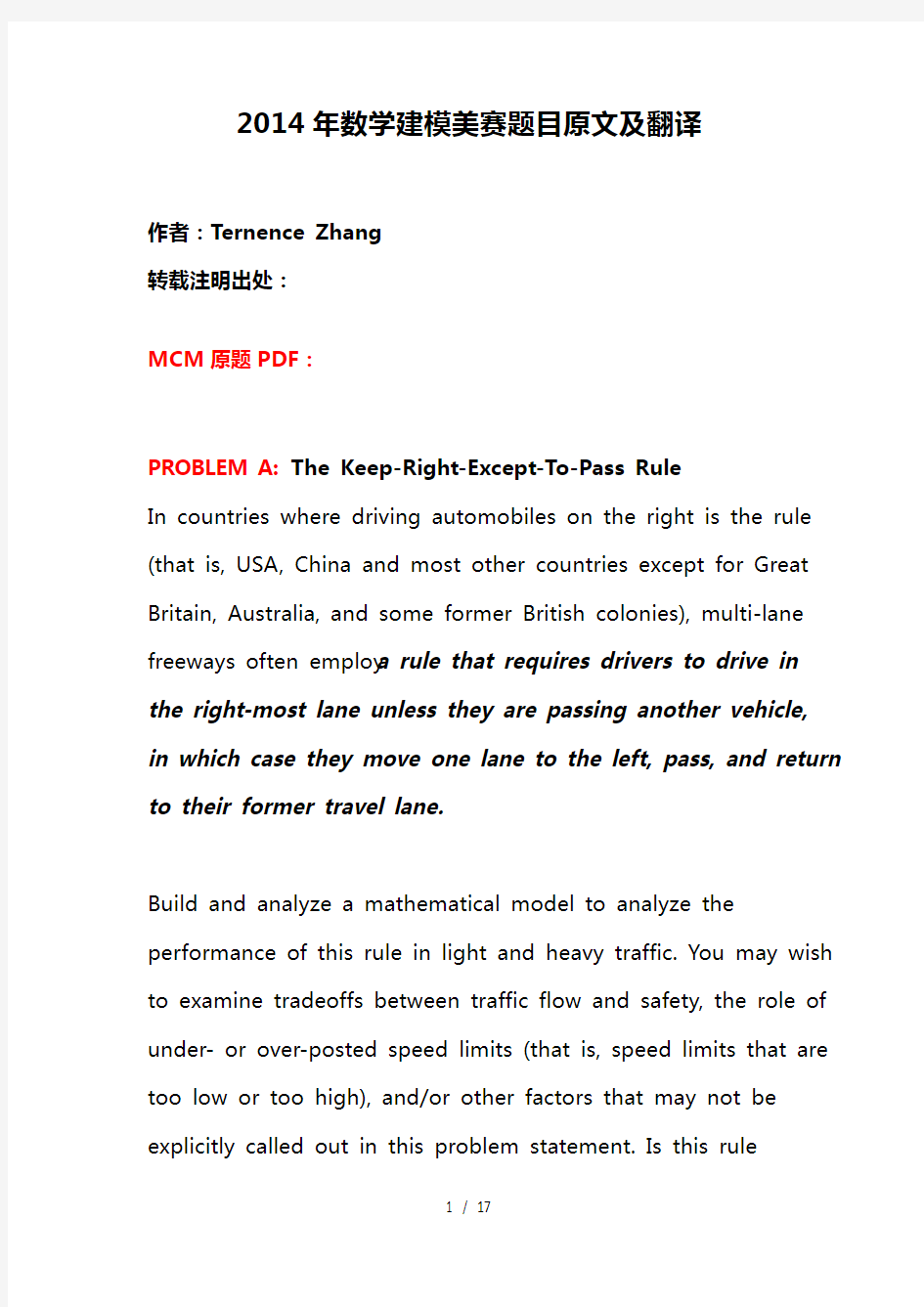2014年数学建模美赛题目原文及翻译

- 1、下载文档前请自行甄别文档内容的完整性,平台不提供额外的编辑、内容补充、找答案等附加服务。
- 2、"仅部分预览"的文档,不可在线预览部分如存在完整性等问题,可反馈申请退款(可完整预览的文档不适用该条件!)。
- 3、如文档侵犯您的权益,请联系客服反馈,我们会尽快为您处理(人工客服工作时间:9:00-18:30)。
2014年数学建模美赛题目原文及翻译
作者:Ternence Zhang
转载注明出处:
MCM原题PDF:
PROBLEM A: The Keep-Right-Except-To-Pass Rule
In countries where driving automobiles on the right is the rule (that is, USA, China and most other countries except for Great Britain, Australia, and some former British colonies), multi-lane freeways often employ a rule that requires drivers to drive in the right-most lane unless they are passing another vehicle, in which case they move one lane to the left, pass, and return to their former travel lane.
Build and analyze a mathematical model to analyze the performance of this rule in light and heavy traffic. You may wish to examine tradeoffs between traffic flow and safety, the role of under- or over-posted speed limits (that is, speed limits that are too low or too high), and/or other factors that may not be explicitly called out in this problem statement. Is this rule
effective in promoting better traffic flow? If not, suggest and analyze alternatives (to include possibly no rule of this kind at all) that might promote greater traffic flow, safety, and/or other factors that you deem important.
In countries where driving automobiles on the left is the norm, argue whether or not your solution can be carried over with a simple change of orientation, or would additional requirements be needed.
Lastly, the rule as stated above relies upon human judgment for compliance. If vehicle transportation on the same roadway was fully under the control of an intelligent system –either part of the road network or imbedded in the design of all vehicles using the roadway –to what extent would this change the results of your earlier analysis?
问题A:车辆右行
在一些规定汽车靠右行驶的国家(即美国,中国和其他大多数国家,除了英国,澳大利亚和一些前英国殖民地),多车道的高速公路经常使用这样一条规则:要求司机开车时在最右侧车道行驶,除了在超车的情况下,他们应移动到左侧相邻的车道,超车,然后恢复到原来的行驶车道(即最右车道)。
建立和分析一个数学模型,来分析这一规则在轻型和重型交通中的性能(即车辆较少和交通较拥堵时)。你可以研究交通流量和安全二者间的平衡,最高或最低车速限制的作用(即,过低或过高的车速限制),和/或其它在这个问题陈述中没有明确说明的影响因素。这条规则能否有效地提升交通流量?如果不能,请分析并建议一个替代方案(可能和上述规则的类型完全不同),这个方案可以提升交通流量,安全性,和/或您认为重要的其他因素。
在规定汽车靠左行驶的国家,证明您的解决方案能否简单地改变方向就可应用在这些国家,或是否要考虑额外的要求。
最后,如上所述的规则依赖于人的行为标准(即人们是否遵守这样的交通规则)。如果相同的交通情况完全在一个智能系统的控制之下——无论是道路网的部分或是行驶在道路上的车辆都嵌入了这个系统——在何种程度上,这会改变你刚才分析的结果?
文献:
机动车方向盘右置右行方案对安全的影响:
全球化和汽车左行的制度:
我国高速行驶汽车右行的力学分析_朱耀淮:
交通流模型的建立:
Modern_Freeway_Traffic_Flow_Models:
汽车超车安全辅助判断系统的研究_许颖:
京津塘高速公路通行能力研究:
考虑超车换道:
基于超车行为的双车道公路通行能力分析:
多车道交通流控制模型研究与稳定性分析:
Patent.System_to_Aid_a_Driver_Whether_to_Change_Lanes:换车道模型研究:
美国加州高速公路管理法规:
美国道路交通管理特点:
路段通行能力的理论探讨:
驾驶员车道变换行为模拟分析_魏丽英:
基于元胞自动机的交通流模型研究_邹杰:
高速公路智能汽车自动超车控制算法仿真研究:
基于仿真分析的高速公路车辆当量换算系数研究:
基于仿真分析的高速公路车辆当量换算系数研究_金双泉:
基于不同限速条件下的超车模型研究_柏伟:
一种改进的超车模型_唐铁桥:
车辆跟驰模型:
基于超车率的双车道公路服务水平量化研究_刘江:
